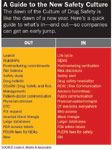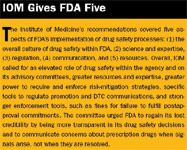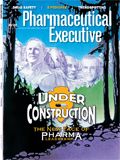Culture Shock
Pharmaceutical Executive
What's old and established is in, what's new-and once interpreted as"better"-is out
Culture is defined as patterns of human activity communicated through rituals and symbols. In healthcare, the pharmaceutical industry fosters cultural change in by developing treatments that alter the practice of medicine. But now, the culture of the industry itself is facing profound change, as society—and FDA—focuses increasingly on drug safety in the wake of the withdrawal of Vioxx (rofecoxib) and questions surrounding the safety of Avandia (rosiglitazone).

A Guide to the New Safety Culture
We can already see signs of this cultural shift. Take Arcoxia (etoricoxib), the new Merck product designed to enter the COX-2 market. There was no evidence that Arcoxia was very different from other COX-2 drugs, and the FDA advisory committee voted Arcoxia down 20-1, and FDA rejected the drug. In years past, Merck might have won with its argument that patients needed another option. In the new culture of safety, however, concerns over risks carried the day. (Disclosure: As a former member of the Drug Safety Advisory Committee, I voted against the approval of Arcoxia and for the continued marketing of Vioxx.)
Reflecting this new culture, FDA is making structural changes to the way it reviews drug safety. Some changes are based on recommendations from an Institute of Medicine (IOM) report entitled The Future of Drug Safety. (See "IOM Gives FDA Five,".) In line with IOM's recommendations, FDA created the office of Drug Safety Policy and Communications and increased its postmarketing staff by 25 percent to 132 positions. The agency has also created an internal Drug Safety Oversight Board, issued drug safety alerts and public health advisories at a more rapid pace and earlier in the drug safety investigation process, and is beginning the public hearing process on a variety of drug safety assessment and communication issues.
Still, it is difficult to know what specific new requirements will emerge. Through the Office of Management and Budget, the administration has voiced its concerns about the FDA Revitalization Act (S-1092), which proposes sweeping changes in drug safety tied to user fees, and which the Senate passed by a vote of 93-1. House bill HR-1561, similar to the Senate bill, was recently introduced, adding more fuel to the drive for change in the way FDA regulates drug safety.
Currently, we don't know what a new law will specify. But we are starting to better understand what FDA's new philosophy of drug safety means and how it will affect the regulation of drug development and marketing.

IOM Gives FDA Five
From Launch to Life cycle: Sales and Safety
We used to see drug safety as something that was dealt with during drug development. Once a drug launched, marketing was supposed to run the show. But in the new Culture of Drug Safety, the side effects of drugs remain under the microscope not only after launch but throughout the product's life cycle.
That's a big change for pharma. For the past few decades, companies have maintained an inordinate focus on drug launch. The time between the FDA approval letter and the initiation of a drug's marketing and sales effort has been like the birth of a favored child. With today's new focus on safety, the child may still be favored, but it is much clearer that, as with a newborn, we don't know much about it. We think we know its potential to treat disease, but we no longer have sufficient experience to fully characterize its safety profile.
Expect more physicians to wait for a new drug to establish a safety record before prescribing it. What's old and established is in, what's new—and once interpreted as "better"—is out. Currently, the industry thinks large postapproval safety studies pay off only if they don't show a risk. In the future, the reduction in uncertainty gained by doing these studies will be the payoff. Ironically, marketing advantage will go to drugs with a safety benefit as opposed to an efficacy advantage.
Under this paradigm, companies must move away from trying to reach peak sales as quickly as possible. Instead, they must learn to build drug adoption slowly and steadily while increasing physicians' and patients' confidence that they understand a product's risks. And though this method means companies will have to rethink their classical approach to life cycle marketing, the bright side of this new culture of safety is that it will also be harder for the competition to gain acceptance for a substitute product.
In the new Culture of Drug Safety, FDA will perform formal drug safety reviews after approval. Look for scheduled reviews of drug risks every three to five years. Companies will need to formally demonstrate product benefits both before and after approval to receive a fair review of drug safety. (We'll have more to say about reviews in the next installment of this series.)
With more pharmacoepidemiologists sitting on FDA advisory committees—per IOM's recommendations—expect more requests for postmarketing safety studies. Companies will continue to conduct postmarketing commitments in the form of small studies, database analyses, and registries. The big difference is that companies will have to deliver what they promise. In 2006, the inspector general reported that about one-third of the annual company-submitted reports used to track these commitments were entirely missing (presumably not submitted) and that more than one-third of those present lacked required information. In total, FDA could not track whether companies had followed through on postapproval promises 74 percent of the time.
Expect FDA to do more thorough follow-up to ensure that Phase IV and other study commitments are kept. Bills currently before Congress grant FDA new authority to enforce commitments and delineate processes leading to fines and new drug application (NDA) withdrawal if they are not met.
FDA has already taken steps to improve drug safety by controlling postapproval use. Under a May 2005 guidance, FDA may ask companies (or companies may volunteer) to prepare a Risk Minimization Action Plan (RiskMAP) when new risks are discovered. These plans specify what companies will do and what tools, such as Medication Guides or restricted distribution, they plan to use to mitigate known risks.
The Senate and House bills, however, go a step further and include the requirement that companies submit a Risk Evaluation and Mitigation Strategy (REMS) for all drugs. Like a RiskMAP, a REMS includes plans for continued risk assessment. But a REMS also includes a plan for a postmarketing research agenda to track drug safety.
The Culture of Drug Safety has spoken: Risk-management programs will become the norm. The key for marketers is to find the holy grail of risk mitigation: risk-management tools that protect patients, but whose restrictions don't kill the drug. After all, certain risk-management interventions have been interpreted by doctors as an attempt to transfer liability for drug safety from drug company to physician. That happened with GlaxoSmithKline's Lotronex (alosetron). When physicians were required to sign an agreement stating that they would fully warn the patient—and get the patient to sign an agreement stating that they had—gastroenterologists refused to prescribe Lotronex, and sales plummeted. We are now likely seeing similar liability concerns with Avandia.
In addition to risk-management programs, FDA is looking at new ways to discover drug safety risks at an earlier stage of marketing. For example, FDA recently held hearings on sentinel networks—mechanisms to receive and investigate very early cases that may signal safety concerns.
The problem for drug safety, however, is not usually the identification of new safety signals. Rather, it's qualifying and quantifying these signals so we can understand, or at least hypothesize, which are real concerns and which are only "noise in the system."
To do that, it is necessary to have extremely large databases of patients who have used the drug. Companies currently use databases for postmarketing cohort and case-control studies, and these will grow into even larger databases that can explore drug outcomes earlier and more efficiently. Look for FDA to work with other government entities such as the VA and Medicare to establish large databases, and expect companies to mirror such actions.
Certainly, early warning of safety signals for drugs on the market is an appropriate goal. Once we have a signal, we will need a safety study to determine whether the signal is real or an artifact. There is a clear evidence hierarchy in drug safety. If the signal is generated by spontaneous reports, a case-control study is needed. If it is generated by case-control studies, then a cohort study is needed. If it is generated by a prospective cohort study, then a randomized trial is needed. As in the case of Vioxx, if the signal is generated by an active-control trial, then a placebo-controlled trial is needed. As we have seen from Avandia, when the signal comes from a meta-analysis, it may require additional safety studies.
Risk Communications, the New Province of FDA
With Vioxx and now with Avandia, perhaps the biggest blow to FDA's credibility came from the perception that the agency had hidden the drugs' cardiovascular risks. Now all eyes are on the agency to ensure it appropriately communicates risk information. Historically, FDA has maintained a strong press office but has relied on drug company materials (e.g., labeling, "Dear Doctor" letters, etc.) to foster specific risk messages.
But with a string of new initiatives implemented over the last two years, FDA has stepped into the business of communicating safety information to the public. The agency has held hearings, issued a new draft guidance on risk communication, and created a new office of Drug Safety Policy and Communications. Look for a return of the long-defunct FDA Drug Bulletin, recast as a drug safety newsletter, and the creation of a Risk Communication Advisory Committee (RCAC), mandated by both IOM and Congress.
FDA has become more active at issuing alerts that inform physicians of new information that may change their prescribing. Over the past two years, FDA has issued these alerts on more than 140 drugs, from sleeping pills to antidepressants. Where once FDA would ask sponsors to perform a new safety study to quantify risk signals, the agency will now likely ask for the study—but simultaneously issue an alert.
FDA abides by the precautionary principle as the ethical basis for risk management, and it should. But there needs to be a method to inform the public about the uncertainty value of safety signals and how much confidence should be placed in risk-management messages. In general, more information and insight are needed to steer the healthcare industry through this new territory.
Certainly, the new Culture of Drug Safety demands that more drug information be posted on FDA's already rich—some call it dense—Web site. Already, approval packages providing FDA's risk/benefit analysis are available for some drugs. Based on stipulations proposed in both Congressional bills, these packages are likely to become more consistently available.
FDA and companies are placing an increased emphasis on a drug's label as a way to communicate with patients. In its initial proposal for the new drug-labeling format issued in December 2000, FDA suggested companies use an inverted black triangle to denote a newly approved product. (The agency later settled on listing the approval date.) The Senate bill calls for inclusion of the approval date, while the House bill requires the use of a unique symbol during the first two years of marketing. Other suggestions abound: IOM suggested the black triangle used in the United Kingdom to identify new drugs, singling them out for intense surveillance and greater reporting of observed adverse drug events.
Currently, drug companies and FDA negotiate the language of the label. But IOM and the Congressional bills would provide FDA with the authority to draft the label's language and require it to be updated, without negotiation. This is intended to give FDA more control over labeling and to avoid delays in implementing warnings. FDA, of course, already wields enormous influence over the language of the label and, as a result, the language of marketing materials. Thus the biggest change may be a matter of new expectations: The public will expect FDA to disseminate warnings rapidly. This will put pressure on companies and the agency to resolve differences as quickly as possible.
So where does this leave DTC advertising—the expected casualty of the Vioxx withdrawal? IOM and both Congressional bills have included at some point a moratorium on DTC during the initial two or three years of marketing. Some have argued for the idea of provisional approval, limiting certain marketing tactics (such as broadcast DTC) during the early phases of marketing. This is thought to create a slower adoption period, allowing more time to discover and mitigate new risks. But Congress is still making compromises. One bill maintains up to a three-year moratorium on DTC broadcast advertising, while the other bill recently deleted a provision that would have required DTC preapproval by FDA and fines if ads were found to be misbranded.
Free speech advocates may prevail, but a selective ban on DTC is already in place: Lilly's Forteo (teriparatide), Lilly and Amylin's Byetta (exenatide), and BMS drugs across the board have proposed avoiding DTC broadcast advertising, at least initially, as a risk-mitigation tactic. Even if FDA cannot ban broadcast DTC altogether, the agency can force greater disclosure of risk in a fair balance statement. This may make it extremely difficult to create an advertisement with a reasonable benefit/risk balance, unless the two-and-a-half-minute DTC commercial initiated by Celebrex (celecoxib) is a portent of things to come.
Nothing currently has the reach of broadcast advertising. But if staying power and slow uptake are the goal, we may see more personal sources of information to deliver drug information to consumers. Look for innovative ways to foster patient-based opinion leadership and word-of-mouth promotion and an increased use of interactive Web-based applications. Expect a much more complex and targeted set of interventions as personalized medicine and consumer segmentation continue to evolve. Direct but targeted messaging to consumers and patients in each of the stages of product usage and life cycle will be the new grail for consumer communication.
How will we pay for all these changes? User fees, most likely. Once considered a quid pro quo for FDA's timely consideration of an NDA, user fees will be applied to DTC review and, if the bills are signed into law, to drug safety. Companies will pay to keep their drugs on the market or to have them withdrawn.
The Culture of Drug Safety will continue to foster changes in our philosophy of drug use, the process to determine safety, and the procedures we use to mitigate risks. It will last throughout the life cycle of the drug. This culture will be stimulated often by early announcements of safety signals by FDA, journals, and drug companies. It will be amplified by the press and Congress.
This is the first of three articles on the Culture of Drug Safety. In the next two installments, we will explore further the implication of life cycle risk management and public-risk communications.
Louis A. Morris is president of Louis A. Morris & Associates. He providesconsulting and research services to pharmaceutical and communications companies and has authored more than 100 articles and book chapters on health and risk communications. He can be reached at lmorris@optonline.net
The Misinformation Maze: Navigating Public Health in the Digital Age
March 11th 2025Jennifer Butler, chief commercial officer of Pleio, discusses misinformation's threat to public health, where patients are turning for trustworthy health information, the industry's pivot to peer-to-patient strategies to educate patients, and more.
Navigating Distrust: Pharma in the Age of Social Media
February 18th 2025Ian Baer, Founder and CEO of Sooth, discusses how the growing distrust in social media will impact industry marketing strategies and the relationships between pharmaceutical companies and the patients they aim to serve. He also explains dark social, how to combat misinformation, closing the trust gap, and more.
